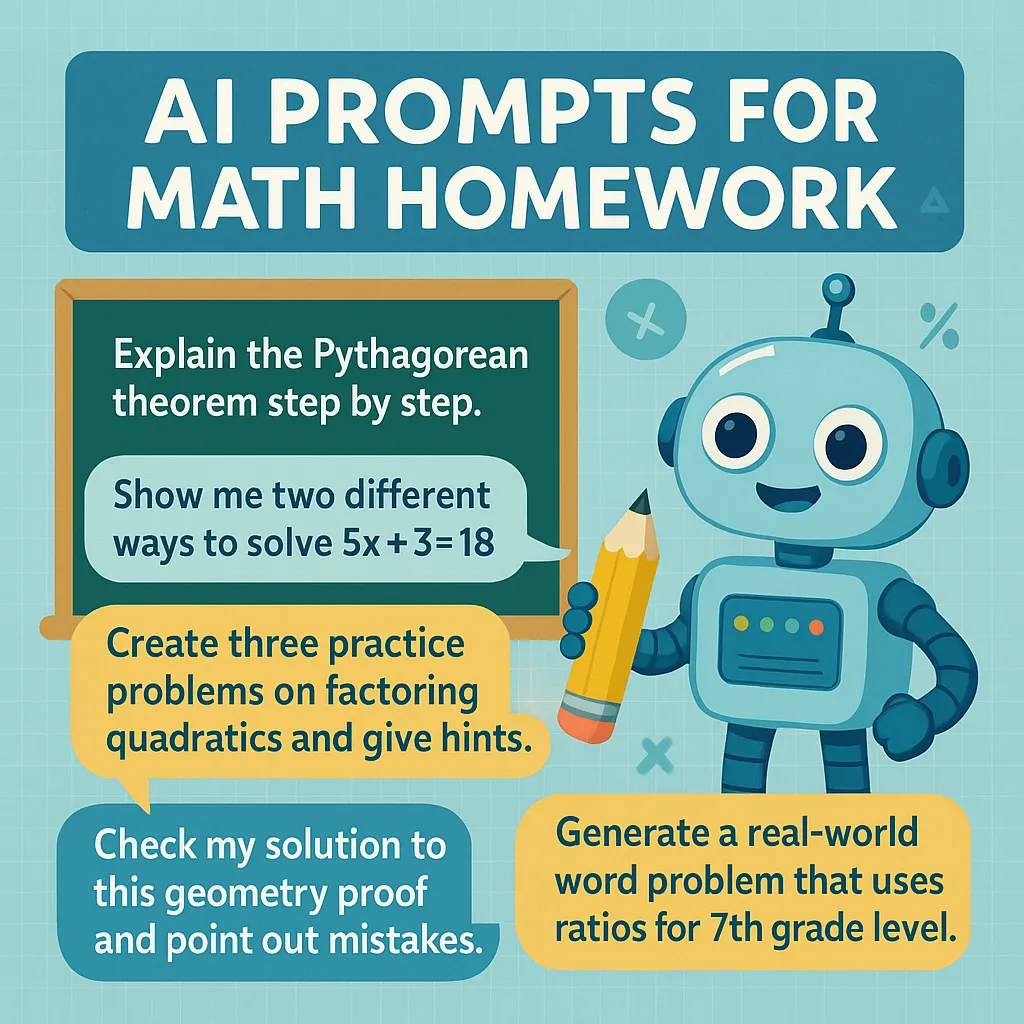
Essential Math Prompts for Homework Success
As educators, we're constantly looking for ways to help our students develop deeper mathematical understanding. When used properly, AI tools can be valuable learning companions that guide students through problem-solving processes rather than simply providing answers. Here are some effective AI prompts students can use to enhance their math learning experience across grade levels.
Understanding the Problem
Before diving into solutions, students need to fully grasp what they're being asked to solve:
"Can you explain this [math concept] in simple terms with a real-world example?"
"What information in this problem is important, and what can I ignore?"
"What's a similar but simpler version of this problem I could try first?"
Learning Through Process
These prompts help students see math as a step-by-step process:
"Show me how to solve this problem step-by-step, explaining your reasoning at each point."
"Can you show me two different approaches to solving this equation?"
"What mistake am I likely making in my solution to this problem?"
Visual Learning Aids
For visual learners or complex concepts:
"Create a visual representation to explain how fractions work."
"Can you draw a diagram that shows the relationship between these variables?"
"Show me a coordinate plane with these points plotted and explain what they represent."
Building Conceptual Bridges
Connecting new concepts to established knowledge is powerful:
"How does multiplication relate to addition? Explain with examples."
"Compare and contrast perimeter and area using everyday objects."
"How does this algebra concept connect to what we'll learn in geometry?"
Grade-Specific Approaches
Elementary (Grades 3-5)
"Explain multiplication using arrays or groups I can visualize."
"Show me how fractions represent parts of a whole using a pizza example."
"Create a story problem about measuring ingredients for cookies that uses fractions."
Middle School (Grades 6-8)
"Explain how negative numbers work on a number line with a temperature example."
"Show me how I can use algebra to solve a problem about finding the best deal at a store."
"Compare linear and exponential growth with a real-world example."
High School (Grades 9-12)
"Break down the quadratic formula and explain when each part becomes important."
"Show me a trigonometry problem and walk through how to approach it systematically."
"Explain how calculus concepts like derivatives relate to physics problems about motion."
Checking Understanding
These prompts help students verify their learning:
"Can you quiz me on the key concepts in this chapter with increasingly difficult problems?"
"What are three common mistakes students make with this type of problem?"
"Generate a similar problem to this one for me to practice with."
Beyond Just Answers
The most valuable AI interactions focus on understanding rather than shortcuts:
"What prerequisite skills do I need to master before attempting this type of problem?"
"How would I explain this concept to someone who's never seen it before?"
"What real-world situations would require me to use this math concept?"
Final Thoughts
As educators, we should encourage students to see AI as a learning partner rather than an answer provider. The best prompts ask for explanations, connections, and deeper understanding rather than just solutions. When students learn to ask better questions of AI tools, they develop critical thinking skills that extend far beyond their math homework.
By teaching students to use these prompts effectively, we're equipping them with powerful metacognitive strategies that will serve them throughout their educational journey.